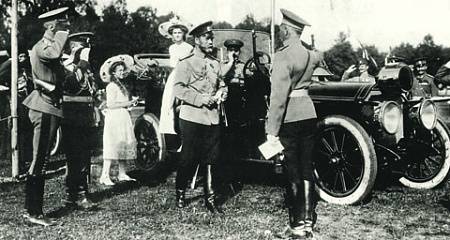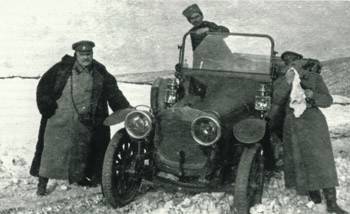The war can not do without cars
 The start of car use in Russia dates back to 1900, and from 1910, the Russian-Baltic Carriage Works in Riga began producing cars, with the company receiving a number of parts and special sorts of steel from Germany. The performance of the plant was extremely insignificant - before 1914, they had produced up to 360 machines. Leitner's factories in Riga, Frese and Leisner and Puzyrev in St. Petersburg produced only test copies of the machines.
The start of car use in Russia dates back to 1900, and from 1910, the Russian-Baltic Carriage Works in Riga began producing cars, with the company receiving a number of parts and special sorts of steel from Germany. The performance of the plant was extremely insignificant - before 1914, they had produced up to 360 machines. Leitner's factories in Riga, Frese and Leisner and Puzyrev in St. Petersburg produced only test copies of the machines.Imports of cars from abroad in the period from 1901 to 1914 year was about 21 thousand units. But of this total number of 21 360 machines more than 30% (over 7 thousand units) by the beginning of 1914 of the year were out of order, and on the eve of the war, there were thousands of cars in 13 - only about 5,2% (259 cars, 418 trucks and 34) special) belonged to the military department.
At the same time, motor transport on 40% was concentrated in large centers - in St. Petersburg and Moscow.
For comparison: on the 1913 year in England there were 90 thousand (including 8 thousand trucks), in France - 76 thousand, Germany - 57 thousand (including 7 thousand trucks) cars.
During the period from 1901 to 1914, about 9 thousand motorcycles were imported to Russia, and on the eve of the declaration of war, there were (minus worn out) a little more than 6 thousand units.
In general, German cars prevailed among imported cars - with the declaration of war these cars were cut off from the supply of spare parts. In addition, the car park in Russia was distinguished by a variety of types of makes and models of cars, which eliminated the possibility of organizing a case of serial repair of vehicles. The auto repair shops for 1913 in Russia totaled 35, plus 93 workshops in garages.
Thus, the country's general resources, both in terms of vehicles and repair facilities, which could be used by the military when declaring war, were insufficient.
CAR CARS
The military department still in 1910 requested the creation of special automobile companies and their introduction into the army. In the same year, with nine railway battalions in European Russia and the Caucasus, fifth companies were created to test vehicles, select models of vehicles most suitable for military service, and train lower technical personnel. The personnel of the company is an 4 officer and about 150 soldiers. In the established company were transferred available in the army cash cars. In addition, an automotive training company was formed, which was entrusted with the task of training non-commissioned officers and officers for automobile military units.
The overall leadership of the automobile business in the Russian army was concentrated in the military communications department of the General Directorate General Staff.
In 1911, the War Department acquired 14 trucks of the best foreign firms, testing them with a mileage of 1,5 thousand miles. In 1912, competitive runnings of passenger cars were organized along the route of a total length - along the highway about 2 thousand versts and along dirt roads around 900 versts - and trucks up to 2340 versts (along the highway).
In addition to creating automobile companies, measures were taken to supply cars and motorcycles to military headquarters up to and including individual brigades, as well as to supply fortresses to cars and trucks.
In 1913, technical issues regarding automotive parts were transferred to the Main Military Technical Directorate (GVTU).
The War Department decided to form individual autorotates for 29 and intended to implement this plan within three years - in 1914 – 1916. The staff of a peacetime company was: 8 officers, 4 official, 206 soldiers, and in wartime 11 officers, 4 official and 430 soldiers.
On mobilization from the population it was received: cars - 3562, trucks - 475 and motorcycles - 1632, and all cars - 5669. This figure was increased by requisitioning in border provinces and in Finland on the basis of the Statute on the Field Administration of Troops - but only slightly.
GROWING NEED
With the beginning of the war, the army's need for cars and motorcycles began to grow rapidly, it became clear that it was necessary to increase the number of automobile companies, sanitary detachments, automobile teams at the headquarters of the fronts and armies, motorcycle teams to carry out communications services at the headquarters of armies and cavalry divisions. In addition, cars and motorcycles were required to meet the special needs of artillery, aviation, aeronautical and other military units, as well as in the reserve to replenish the loss.
In May 1915 of the year, the General Staff made a calculation for which it was planned to have: 2 autotypes per army (15) and reserve each front, a motorcycle team per army, an automobile squadron for each corps (60) and one motorcycle for each cavalry division (45). To meet the needs of the army in cars and motorcycles in 1914 – 1915, orders were made in America and European countries for 12 thousand cars and 6,5 thousand motorcycles. The annual army demand was determined in the following figures: cars - 14 788, motorcycles - 10 303.
On October 1, 1917 was sent to the army and ordered up to 30,5 thousand cars (of which 711 were in the military before the war and about 3,5 thousand entered by military-motor conscription) and 13 thousand motorcycles.
 OWN PRODUCTION
OWN PRODUCTIONThe whole mass of cars in its composition was extremely motley. Accordingly, the military department in 1916 tried to organize the production of cars in Russia.
In February, GVTU 1916 signed five contracts for the manufacture of cars, the execution of which included the construction of the following plants:
- Joint-stock Moscow Society (AMO) in Moscow;
- Russian-Baltic - in Fili near Moscow;
- Lebedeva - in Yaroslavl;
- Russian Renault - in Rybinsk;
- Aksay - in Rostov-on-Don.
Contractors were obliged to build, equip and operate plants no later than 7 in October 1916 of the year, and the order assigned to them for 7,5 thousand cars to fulfill in October 7 of 1918 of the year.
In May, the GVTU 1916 signed a contract with the British engineering company Becos for the construction of a car factory near Mytishchi, designed for the annual production of 3 thousand cars.
Work on the construction of new plants was in full swing, but the Allies after the February Revolution inhibited the execution of Russian orders. As a result, work on the construction and equipment of automobile plants by October 1917, almost ceased.
Thus, the availability of road transport in Russia in 1914 in quantitative terms made it possible to meet the needs of the army for the first time after the declaration of war, but out of this amount, it was possible to take only 30% of the country’s available to the army at the time of mobilization of vehicles. At the same time, the vehicles taken from mobilization, which even needed minor repairs, could not be used for service for a long time due to the lack of funds for repairs.
The military department was not able to properly use the data of the organized mileage and the use of vehicles in the autorots and did not stop its choice on any particular type of car. The latter were purchased from almost all European factories. As a result, the military department was forced to take what was available on the market, bringing this even greater diversity to the fleet of military vehicles.
PROBLEMS WITH SPARE PARTS
During the war, spare parts for motor vehicles were ordered by the military department at the same time as cars. In the first period of the war, they were acquired in the amount of up to 35% of the cost of the cars themselves and were completely spent for two and a half years - thus, the annual consumption of spare parts amounted to 14% of the cost of cars.
The lack of production and mining in Russia of many materials needed for car repair (special grades of automobile steel, spring and spring steel, brass, tin, etc.) made it necessary to import them from abroad, which made supplying the army dependent on the allies' discretion - in particular, England, disposed of sea tonnage. The result was frequent interruptions in the supply of materials, causing an increased idle car repair (up to six months).
The front-line road network, which had an extremely limited number of highways, soon became unusable due to heavy traffic and the lack of proper repairs. Temporary roads - timbered, wooden, of poles, etc., built by road parts, were of little use for motor vehicles.
Low qualifications of the driver’s staff and poor road setting caused a large percentage (50 – 75%) of cars to lose, and repair shops created during the war could not cope with their task due to the lack of spare parts, materials and equipment.
The supply of military vehicles with maintenance materials depended on foreign countries only to the extent of rubber. About 50% of tires was imported, the rest was made domestically - but the raw material went again from abroad. Lubricants and combustible materials were almost 100% Russian production.
Finally, the autorot organization was very cumbersome, and this cumbersome increased as a result of the imposition by the autorotam of the tasks of supplying and repairing motor vehicles of military units and headquarters — this explained the low mobility of the autorot, which made their operational transfers extremely difficult.
But, despite all these problems, the First World War was an important milestone in the organization of the automobile troops of Russia.
Information